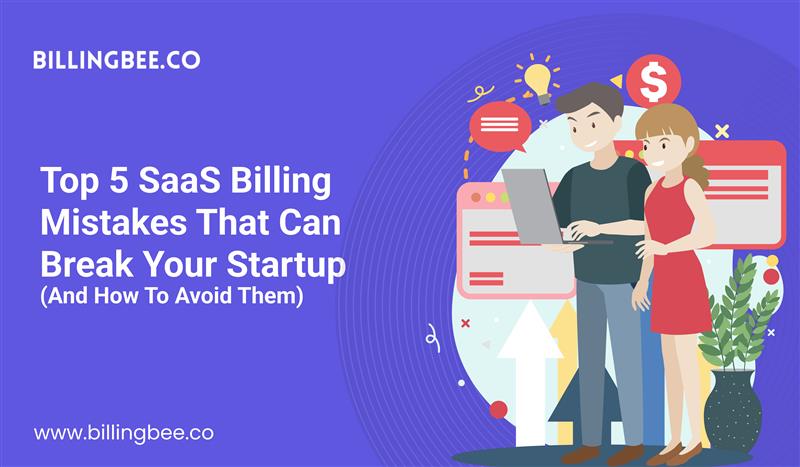Top 5 SaaS Billing Mistakes That Can Break Your Startup (and How to Avoid Them)




Running a startup is already an uphill battle. But for SaaS businesses, the difference between scaling fast and shutting down can often come down to one factor—billing. Many founders underestimate how critical a robust billing system is until they find themselves drowning in churn, cash flow issues, or compliance nightmares.
In this article, we’ll dive into the top 5 SaaS billing mistakes startups make, why they’re so dangerous, and most importantly—how you can avoid them before they sabotage your growth.
1. Treating Billing as an Afterthought
When you’re building your SaaS product, billing often feels like a “back office” task. After all, it’s not as exciting as new features or customer acquisition. But here’s the truth: if you don’t set up a reliable billing infrastructure from the start, you’ll eventually hit roadblocks.
Why it’s a mistake:
- Leads to payment delays and revenue leakage
- Creates frustration for customers when invoices are unclear or inaccurate
- Makes scaling harder when you suddenly have hundreds of paying users
How to avoid it:
Invest in billing software designed for SaaS early on. Look for solutions that handle recurring payments, tax compliance, invoicing, and subscription management out of the box. This not only saves you time but also prevents financial chaos down the line.
2. Ignoring Global Compliance and Tax Regulations
Startups often dream global from day one, but their billing systems remain stuck in local mode. If you’re serving international customers, overlooking VAT, GST, sales tax, or e-invoicing requirements can quickly put you in hot water.
Why it’s a mistake:
- Can lead to hefty fines or penalties from regulators
- Creates mistrust with global clients who expect compliant invoices
- Stalls expansion into new markets
How to avoid it:
Choose a billing solution that integrates with global tax rules and updates automatically when laws change. This ensures that whether you’re billing a customer in Berlin or Bangalore, your invoices remain compliant.
3. Offering Complicated or Inflexible Pricing Plans
SaaS thrives on flexible subscription models—monthly, yearly, usage-based, tiered. But many startups either lock themselves into rigid pricing structures or overcomplicate them so much that customers walk away.
Why it’s a mistake:
- Rigid plans limit revenue opportunities from different customer segments
- Confusing pricing creates friction at checkout and reduces conversions
- Makes it hard to experiment with pricing strategies
How to avoid it:
Adopt a flexible billing system that allows you to test and roll out new pricing models without requiring weeks of developer time. Keep pricing simple and transparent, and use customer feedback to refine your tiers.
4. Poor Handling of Failed Payments (a.k.a. The Silent Killer)
Every SaaS founder knows the pain of churn. But what if I told you that a large chunk of your churn isn’t voluntary at all? Failed payments due to expired cards, insufficient funds, or network errors silently kill revenue for many startups.
Why it’s a mistake:
- Leads to “involuntary churn” where customers leave without meaning to
- Causes embarrassing emails about payment failures
- Results in lost lifetime value (LTV) for your business
How to avoid it:
Implement smart dunning management—automated retries, reminders, and flexible payment options. Even small changes like sending a payment update link can drastically reduce failed payments and retain customers who would otherwise churn.
5. Not Using Billing Data to Drive Growth
Your billing system isn’t just about collecting money—it’s a goldmine of insights. Unfortunately, many startups never look beyond their revenue dashboard.
Why it’s a mistake:
- You miss trends in customer behavior, upgrade/downgrade patterns, and churn risks
- Limits your ability to forecast growth and cash flow accurately
- Leaves opportunities on the table to upsell or cross-sell
How to avoid it:
Leverage billing analytics to track MRR (Monthly Recurring Revenue), churn rates, ARPU (Average Revenue Per User), and cohort analysis. This data helps you make informed product and marketing decisions that directly fuel growth.
Final Thoughts
SaaS billing mistakes may seem small at first, but they compound over time—eroding trust, revenue, and scalability. By addressing these five challenges head-on, you’ll not only secure your startup’s financial foundation but also create a smoother experience for your customers.
At BillingBee, we help startups and growing SaaS companies eliminate these pitfalls with automated, compliant, and intelligent billing solutions that scale with you. Don’t let billing break your startup—turn it into your competitive advantage.